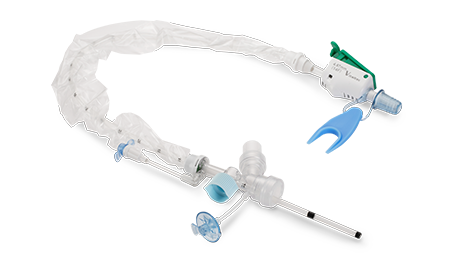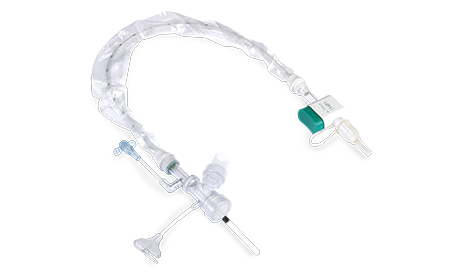Ventilator-Associated Pneumonia (VAP) Infection Control: Best Practices and Proven Prevention Strategies

Ventilator-associated pneumonia (VAP) is one of the most serious and common infections among intubated patients in intensive care units (ICUs). Effective VAP infection control is essential to reduce patient mortality, shorten hospital stays, and lower healthcare costs. This article explores integrated, evidence-based strategies to control VAP, including closed suction systems, subglottic secretion drainage, and oral hygiene protocols.
The Role of Closed Suction Systems in Ventilator-Associated Pneumonia Control
In intubated patients, the incidence of VAP is notably high due to prolonged mechanical ventilation. A systematic review and meta-analysis have shown that the use of closed tracheal suction systems (CSS) is significantly more effective in reducing VAP incidence than open tracheal suction systems (OSS).
CSS reduces the risk of cross-contamination and minimizes disconnection from the ventilator, hereby maintaining lung recruitment and preventing microbial invasion. Patients using closed suction systems experience a notable reduction in ventilator-associated pneumonia rates, underscoring the importance of using closed systems as part of an effective VAP control protocol.
How SSD Supports Effective VAP Control in ICU Patients
One essential technique for preventing VAP is subglottic secretion drainage (SSD). SSD involves the continuous or intermittent removal of secretions that accumulate above the endotracheal tube cuff or Tracheostomy tube cuff, which, if not drained, may seep into the lungs and cause infection.
Clinical research indicates that SSD significantly reduces the incidence of VAP by lowering the microbial load in the lower respiratory tract. SSD has become a cornerstone of VAP risk reduction bundles in ICUs worldwide, especially when combined with other strategies like CSS and oral care.
Oral Hygiene Protocols for VAP Infection Prevention
Oral care is a critical component of ventilator-associated pneumonia control. Effective practices include the use of chlorhexidine (CHX) mouthwash or gel and mechanical toothbrushing. Dental plaque and oral biofilms harbor pathogenic bacteria that may be aspirated into the lungs, especially in ventilated patients.
Studies have confirmed that:
- Mechanical toothbrushing helps physically remove biofilm and reduce oral bacterial load.
- CHX provides antimicrobial action to further lower infection risk.
- The combination of CHX and toothbrushing significantly reduces the incidence of VAP, offering a synergistic protective effect.
To support infection prevention in ICU settings, we offer the SafeOral™ Oral Cleansing and Suctioning Kit, specifically designed for intubated patients. This all-in-one solution simplifies oral care routines, improves compliance, and enhances the effectiveness of VAP prevention protocols.
Regular oral hygiene should be part of the ICU nursing protocol to support comprehensive VAP infection control, and SafeOral™ is a practical tool to help implement these protocols with confidence and consistency.
Optimizing VAP Infection Control with Integrated Approaches
Implementing a combination of closed suction systems, subglottic secretion drainage, and structured oral care protocols is proven to improve ventilator-associated pneumonia control. These interventions could be part of any ICU’s standard care bundle to enhance patient outcomes, prevent infections, and reduce hospitalization costs.
Frequently Asked Questions About VAP Infection Control
CSS allows suctioning without disconnecting the ventilator circuit, reducing the chance of contamination and lung derecruitment that can lead to infection.
SSD removes secretions from above the endotracheal tube cuff or Tracheostomy tube cuff, preventing them from leaking into the lungs and causing infection.
SSD is particularly recommended for patients expected to require mechanical ventilation for more than 48–72 hours, as it significantly reduces VAP incidence.
Regular oral care, including mechanical toothbrushing and chlorhexidine use, helps remove harmful bacteria and biofilm that may be aspirated into the lungs.
Oral care should typically be provided every 4 to 6 hours, or according to ICU protocols, using specialized kits like SafeOral™ to ensure thorough cleaning and infection prevention.
While not entirely preventable, the incidence of VAP can be greatly reduced through a combination of strategies such as CTSS, SSD, oral hygiene, and proper ventilator management.
Effective VAP prevention reduces the risk of complications, shortens ICU stays, lowers antibiotic use, and significantly decreases mortality and healthcare costs.
Clinical Caution
The clinical signs and diagnostic criteria for VAP presented in this article are for informational purposes only. Each patient’s condition is unique, and accurate diagnosis and appropriate treatment require the professional judgment of licensed healthcare providers.
References
Sanaie S, Rahnemayan S, Javan S, Shadvar K, Saghaleini S, Mahmoodpoor A. Comparison of Closed vs Open Suction in Prevention of Ventilator-associated Pneumonia: A Systematic Review and Meta-analysis. Indian J Crit Care Med 2022; 26 (7):839-845. (Link)
You May Also Be Interested In:
👉Understanding Ventilator-Associated Pneumonia (VAP) and Its Impact


